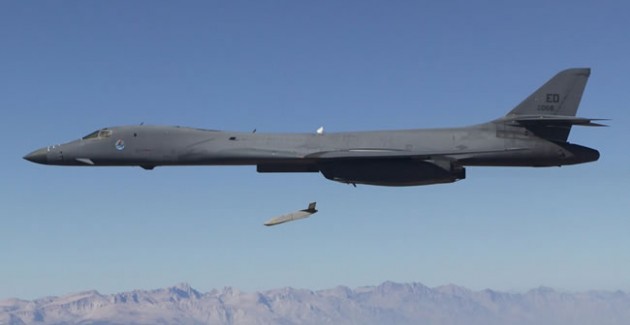Russian Threat Drives Lockheed’s JASSM Sales
Posted on

A B-1 bomber test-fires a LRASM missile, the anti-ship variant of Lockheed’s JASSM
[Updated with Bryan Clark analysis] Lockheed Martin doesn’t like to say it, but their best salesman isn’t getting a bonus this year. That’s because his name is Vladimir Putin.
An increasingly aggressive and well-armed Russia is clearly driving its neighbors to build up their own arsenals, and in highly specific ways. Thus the international success of Lockheed’s Strike Systems division, which builds long-range, radar-evading missiles capable of penetrating a Russian or Chinese-style defense-in-depth.
What countries like Poland, Finland, and Australia all want, despite their differences, is to “hold the threat at bay in a heavily fortified environment,” Strike Systems manager Alan Jackson told me. The Lockheed Joint Air-to-Surface Standoff Missile (JASSM) family, he said, has the range and the stealth to ensure it makes it through an adversary’s heavily defended airspace and hits the target.
Strike Systems’s latest customer is Poland, a country which Russians twice helped Germans wipe off the map. Today, long-range missiles based in Kaliningrad can strike aircraft more than a hundred miles into Polish airspace. That threat obviates current NATO tactics based on unstealthy fighters like the F-16 flying right up to the target to drop smart bombs.
This month, Poland announced a $500 million, 40-missile order for Lockheed-made Joint Air-to-Surface Standoff Missiles. The JASSMs can fit on Poland’s existing F-16s and strike targets more than 200 miles away. Poland has also expressed interest in the extended-range JASSM-ER, whose more fuel efficient (and expensive) engine gives it a whopping 500-plus-mile range.
Lockheed’s other JASSM customer in the neighborhood is Finland, a Russian territory for a century that, once independent, fought Stalin to a standstill in 1940. The Finns are perfectly positioned to fret about Russia’s intentions both in the Baltic, to their south, and in the Arctic, to their north.
Then there’s Sweden, which hasn’t bought JASSMs yet but has publicly expressed interest in the prospective ship-killer version, the Long-Range Anti-Ship Missile. LRASM is another 200-plus-mile weapon. The Swedes have their own history with Russia, made more memorable by present-day concerns about Russian submarines and aircraft probing their waters and airspace.
It’s worth noting that neither Sweden nor Finland is a member of NATO. In the Cold War they maintained a strict neutrality — but this time around, they’re clearly aligned with the West.
Finally, if you look south, NATO member Turkey isn’t buying JASSM, but its state-run armsmaker Roketsan has a joint venture with Lockheed to develop a new cruise missile tailor-made for the F-35 (another Lockheed product). Turkey already has a Stand-Off Missile (SOM), but the weapon is meant to mount under a wing and is too big to fit inside the F-35 weapons bay. The SOM-J (short for Joint Strike Fighter) will trade range and explosive power for compactness, allow Turkish F-35s to carry it without compromising stealth — so they could penetrate some distance into an anti-access/area denial defense and then launch a long-range weapon. Turkey too has centuries of bad experiences with Russia — “The Charge of the Light Brigade” is about Britain’s brief intervention.
Lockheed also has a customer in the Pacific, Australia, where the worry is Chinese A2/AD rather than Russian. And of course there’s the United States itself, which already has 1,946 JASSMs and 160 JASSM-ERs under contract, with at least 110 LRASMs expected for the Air Force alone. US purchases will ramp up to 300 a year next year — assuming the budget doesn’t collapse — and Lockheed has upped its production accordingly. Between the US, foreign clients, and prospective customers he’s not allowed to name, Jackson told me, “growing demand has caused us to expand the production capability we have at Troy [Alabama] to make sure we have plenty of capacity for future contracts.”
It’s not just Lockheed and it’s not just cruise missiles, of course. “The Russian and Chinese threats are definitely driving standoff weapons sales internationally,” said Bryan Clark, a retired Navy strategist now with the Center for Strategy and Budgetary Assessments. “We are seeing a similar dynamic play out in missile defense, where countries are pursuing larger capacity air defense systems, such as PAC-3 (which quadruples the capacity of a Patriot launcher compared to PAC-2), Arrow, and David’s Sling.”
“Other weapons systems where we are seeing the impact of Russian and Chinese A2/AD are new, LACM [land-attack cruise-missile]-capable submarines, which are being considered or purchased by Poland and Germany as well as Australia and Vietnam in the Pacific,” Clark said.
All in all, after a decade and a half of gritty counterinsurgency, high-tech threats are back — if not necessarily the budget to combat them. Those fiscal limits put a premium on munitions, electronics, and other upgrades to existing platforms over all-new, bank-busting planes, tanks, and warships.
Updated 4:00 pm with Bryan Clark comment. Updated 4:20 pm with Lockheed contract figures.
Subscribe to our newsletter
Promotions, new products and sales. Directly to your inbox.
